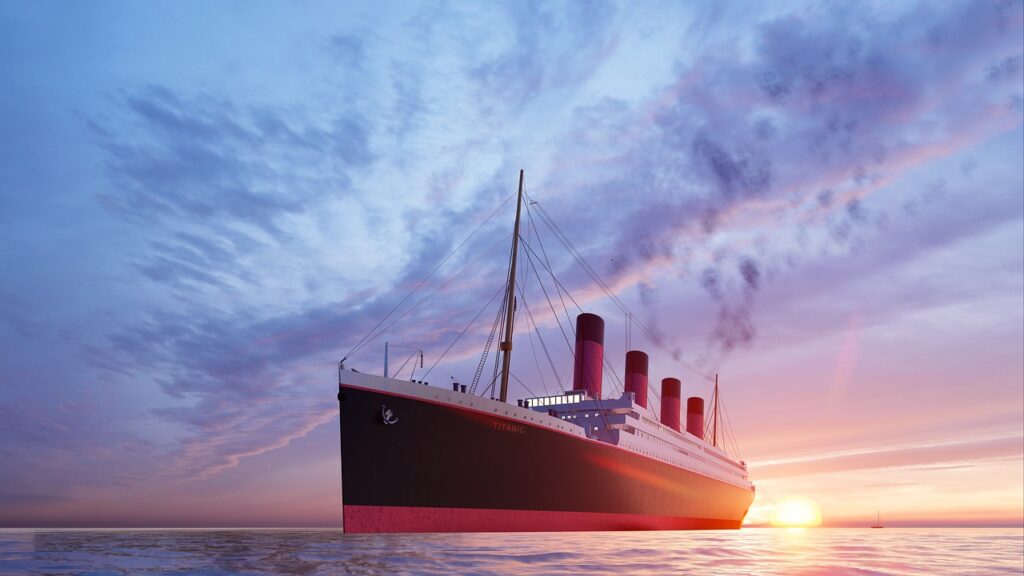The Titanic

The fate of the Titanic is, perhaps, one of the most globally renowned maritime stories in modern history. On this day, 14th April, in 1912, the colossal passenger liner began to sink after striking an iceberg.
In today’s blog, we’re going to delve into the story of the Titanic, given its strong ties to the country and look at its story through a British lens. The ship was constructed here, departed from these shores and has had a deep, lasting impact on British society.
The Titanic was one of the fleet of luxury liners constructed under the shipping company White Star Line. Founded in 1845 in Liverpool by John Pilkington and Henry Wilson, the White Star Line initially focused on routes between the UK and Australia. As their fleet expanded, so did the destinations and they soon called at a vast array of ports around the former British Empire.
Harland and Wolff was one of the largest shipbuilding companies with a renowned shipyard in Belfast, Northern Ireland. It was established in 1861 by Edward Harland and George Wolff and was famous for its knowledge to construct large and complex vessels.
Harland and Wolff were commissioned by White Star Line to design and build The Titanic, as well as its sister ships, The Olympic and The Britannic, in 1907. The Titanic started to be constructed in 1909 and wasn’t finished until April 1912. The scale of the project was enormous, not just because of the size and engineering complexity of the vessel itself but because of the ambition for it to be designed as the most luxurious liner ever created. Vast numbers of highly skilled labourers in and around Belfast were involved in its construction and it was marketed as a pride and joy of the UK.
Once the ship was ready to set sail, sea trials took place on 2nd April 1912 to ensure the vessel was ready for service. After successfully passing all of these, the ship sailed from Belfast to Southampton ready for its maiden voyage to New York City.
Southampton has a poignant connection to The Titanic not only because it was the designated home port for the ill-fated journey but also because a huge portion of the crew manifest, as well as numerous passengers lived here. As you walk around the city today, you find countless references to The Titanic – plaques dotted around the city with information of those passengers who perished, memorials in honour of both the engineers who kept the power running whilst the ship was sinking and the musicians who played until the last minute, and The SeaCity Museum, which highlights the role of Southampton in the story of The Titanic.
The people of Southampton lined the streets and marvelled at the grandeur of The Titanic, wishing it well before its departure on 10th April 1912. After a couple of stops in France and Ireland, the ship set sail across the Atlantic and tragically collided with an iceberg on 14th April before sinking in the early hours of 15th April.
The tragedy of The Titanic sent shockwaves across the country and triggered a period of national mourning, given around 1,500 lives were lost. The city of Southampton suffered terribly as around 700 crew members from this city were lost at sea. The whole city was in mourning, shown by people wearing black armbands, with some families losing multiple members. The initial reaction across the country was immense grief but this soon turned to anger as safety features of the “unsinkable ship” were brought into question. The UK and US governments both opened national inquiries. The Board of Trade, here in the UK, took testimonies of those that survived the tragedy and investigated the disaster to find out who was responsible. Although, ultimately, the ship sank as a direct result of hitting an iceberg, the safety features onboard were not good enough and could have unnecessarily increased the death toll.
This disaster has had a direct impact on maritime regulations in the UK. Following the immediate investigation of this tragedy, new laws were introduced requiring all ships to carry enough lifeboats for every member on board (both passengers and crew), implementing essential training on lifeboat procedure for crew members, ensuring 24-hour radio watch to be able to receive and respond to distress signals and creating SOLAS, an international agreement to set safety standards for ships globally.
Over a century later, the UK continues to have a deep connection to The Titanic, not only through its history but also through culture. The story has been retold and adapted in many British films, series, plays, shows, books and documentaries. If you’re interested in learning more about the story of The Titanic, we recommend The SeaCity museum and The Titanic Trail in Southampton or Titanic Belfast, a museum located beside where the vessel was originally constructed.
The Titanic is a story that continues to resonate with British people to this day and the tragedy is imprinted in the maritime heritage of the country.
Vocabulary
Colossal: (adj) Extremely large
Passenger liner: (n) Large ship that carries passengers
To delve into: (vb) To investigate
Fleet: (n) A group of ships with the same owner
Vast: (adj) Large
Array: (n): Collection
Vessel: (n) Ship
Poignant: (adj) Touching, emotional
Manifest: (nn) List of people on board a ship – in this case crew manifest, list of crew
Dotted around: (adj) Spread around
To perish: (vb) To die
To marvel: (vb) To admire
To trigger: (vb) To cause
Grief: (n) Sadness due to death
Death toll: (n) Number of people who died as a result of a disaster



Responses